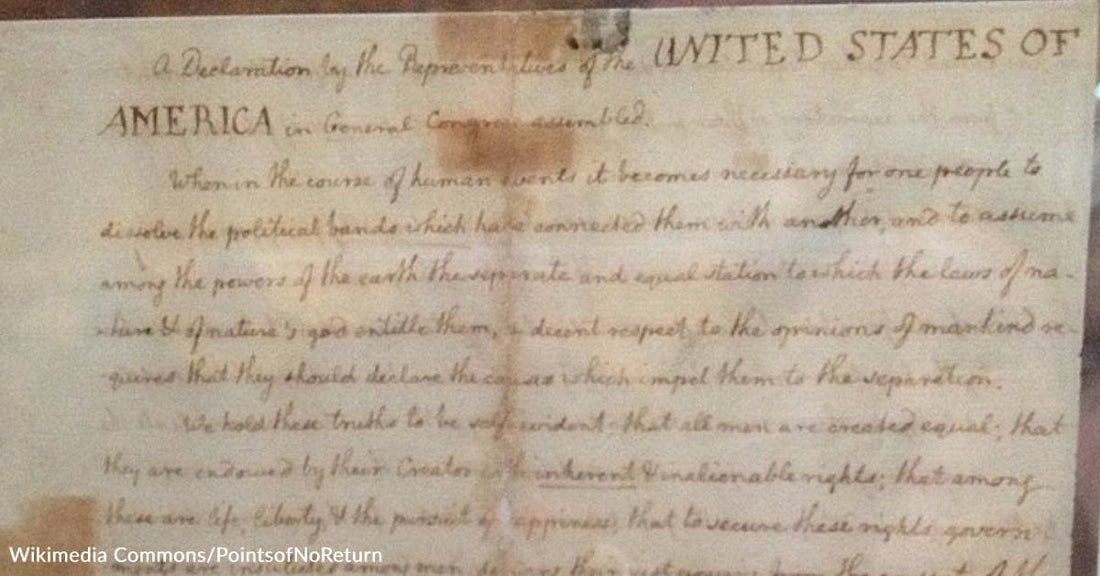Original Copy of Declaration of Independence Found Hiding Behind A Painting
Dan Doyle
You have probably watched a program on PBS called “Antiques Roadshow." It is a fascinating concept, where everyday Americans bring objects from their homes that have been in the family for years, or that they purchased at a yard sale or found in any number of ways, to see if they have any value. The objects are always interesting, and the stories behind them are often quite common, recognizable tales of how they came into the family, etc. Some are surprised that what they thought would be very valuable are, in actuality, fakes, but some turn out to be real treasures.
On one occasion in the past, my wife and I were going through a thrift shop, and I found a framed picture of a magazine cover depicting a Native American woman that I thought quite attractive. I bought it for $5.00 and took it home. On the drive home, the magazine cover slipped in the frame, and I noticed that there was something behind it. I took the frame apart, and, lo-and-behold, behind the magazine cover, was a beautiful ink pen drawing of Notre Dame and surrounding buildings, drawn from the perspective of the walkway along the Seine River below. And it was signed. I still have it. The story below makes me think that maybe I should investigate my findings a bit more.
While browsing my news feed this morning, I found the following story on the IFLSCIENCE site about a similar experience had by an unnamed gentleman back in 1991. It seems that said gentleman was at a flea market and found a painting that he thought was ugly, but he really was more interested in the frame that it was held in. He bought it for $4.00.
When he got home, he dismantled the frame and tossed the painting but, in the process, found that the frame was also poorly made and began to dismantle it. To his surprise, he found a business-sized envelope in the backing of the frame. Upon opening the envelope, he found a copy of the Declaration of Independence, but not just any copy. He did not realize it at the time, but what he had in his possession was one of the 25 original copies printed in July of 1776.
Not surprisingly, maybe, the gentleman was not terribly impressed with the document he found folded in that envelope, thinking that it might be a 19th-century or later copy, but he thought that he might keep it as a curiosity. He held it until a friend of his saw it who was taken by it and suggested that it be taken to an expert to see if it was of any value. The gentleman did get it evaluated and found how important a piece of history it was. He sent it to auction that same year, 1991, and it sold for $2.2 million, which would be about $5 million in today’s dollars.
That copy of the Declaration of Independence went up for auction again in 2000 and sold at that time for $7.4 million. The Sotheby Auction House implied that it was even more valuable because it was only one of seven of the original 25 copies that was unbacked and required no restoration. It was in pristine condition. It is thought that the copy was folded while the ink was still fresh, so it may very well have been put into that envelope immediately after it was printed in Philadelphia in July of 1776.
Imagine the odds of something like this happening. The idea that that copy of one of the most important and most beloved documents in American history would be folded and placed in that envelope and would remain so for 215 years, only to be found hiding behind a rather innocuous painting by a guy wandering through a flea market looking for a usable picture frame in 1991, is beyond curious. Why that envelope was placed in that frame, behind that painting, and by whom, and why it was forgotten about and then ended up in a flea market in the late 20th century, is curious enough to have a fine piece of Pulitzer Prize fiction written about it. In any case, it is quite a story in its own right.
Beyond the pure luck of having found one of the first 25 copies of the Declaration of Independence in pristine condition over two centuries after it was printed, it is a miraculous thing to have this famous document still with us. It is history made present to us, deserving of our awed respect. It is one of the most eloquent statements about freedom and our natural human rights ever written.





